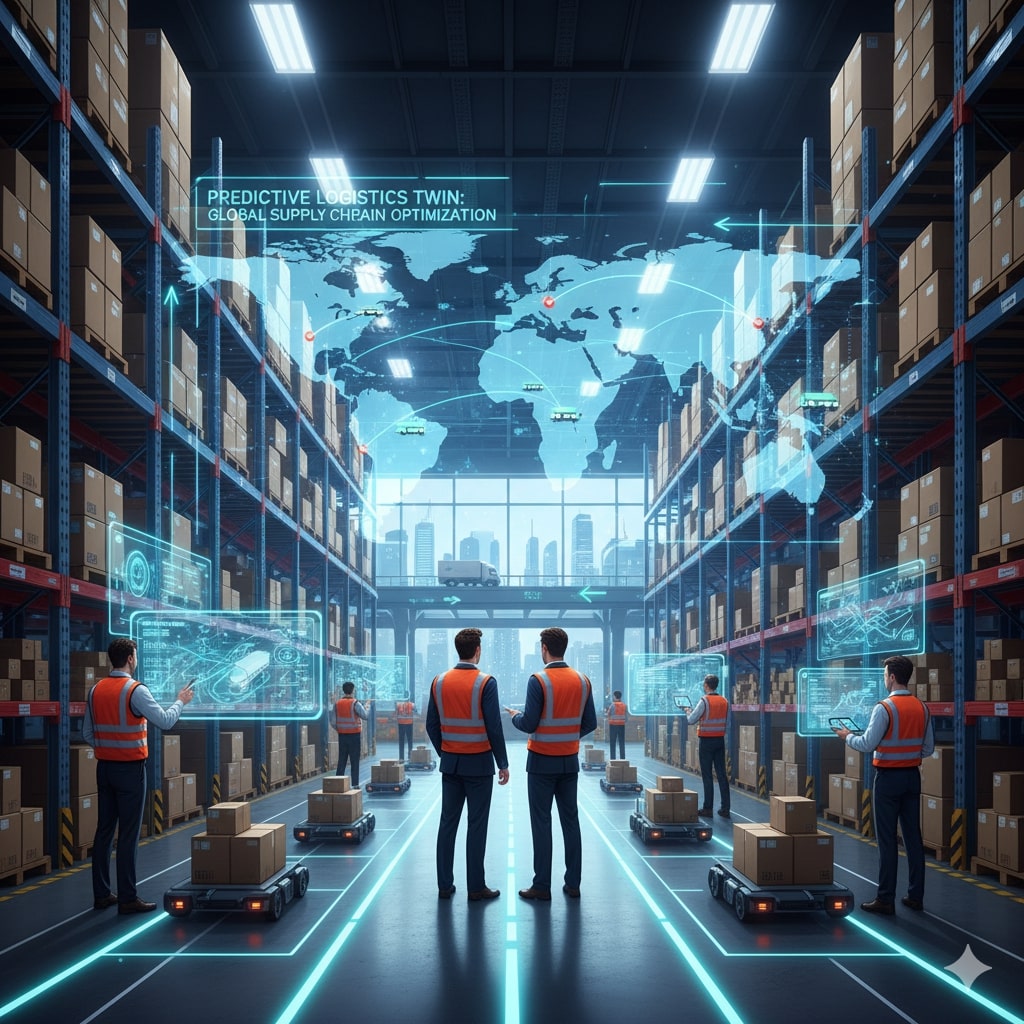Digital Twins Go Predictive: The Next Leap in Real-Time Logistics Simulation
By the year 2025, logistics have transformed from just tracking shipments and optimizing routes to a point where simulating the whole supply chain is a prerequisite of nothing happening in the physical world. Digital twins, which are virtual representations of logistics networks, have changed the concept of operational control. However, the actual advancement took place when these digital twins became predictive instead of just reactive.
Digital twins powered by AI and real-time data now foresee future disruptions, measure the ripple effect of each decision, and instantaneously provide the best strategies. Rather than looking at the past, “what went wrong,” logistics leaders can now inquire about the future, “what will happen next,” by means of testing.
The Evolution from Digital to Predictive Twins
Digital twin systems of the past were inactive, so to speak—they only portrayed the data related to assets, warehouses, and fleet but could not perform any outcome projections. However, this situation underwent a major transformation in 2025. The incorporation of machine learning, IoT sensors, and simulation models in predicting digital twins results in a living, learning ecosystem that progresses together with the actual supply chain.
Here are the core capabilities of predictive twins transforming logistics today:
- Scenario forecasting — examining delivery timelines' sensitivity to fluctuations in fuel costs, delays, or demand spikes.
- Predictive maintenance — anticipating the life of the equipment and determining the best time for maintenance to avoid breakdowns.
- Real-time synchronization — making warehouse, transport, and supplier operations run in unison through the use of real-time data.
- Risk simulation — predicting the impact of geopolitical, environmental, or supplier disruptions by modeling them beforehand.
These systems function as a living mirror — reflecting every movement, truck, and decision across global networks. When combined with AI, the twin doesn’t just react to issues — it prescribes proactive solutions.
How Predictive Digital Twins Work
Visualize a logistics network that acts out a new trade route beforehand and no cargo even goes out of the port. Artificial intelligence models collect information from various sources like sensors, weather predictions, customs application programming interfaces, and enterprise resource planning systems to foresee results like the time of delivery, cost changes, and environmental impact.
At the moment of the model finding a possible bottleneck, for instance, traffic in Rotterdam or a high temperature affecting the cooling of goods, it will suggest a new route or modify the distribution of stock automatically.
According to Gartner’s 2025 Supply Chain Tech Outlook, companies using predictive twins achieved 32% fewer operational disruptions and improved delivery accuracy by up to 27%. Giants like Maersk, Siemens, and DHL already use digital twins to simulate logistics scenarios across global hubs.
Lab42’s Predictive Twin Framework
At Lab42, we help logistics companies go beyond visualization — we enable real-time decision intelligence. Our predictive twin framework connects IoT telemetry, transportation management systems (TMS), and AI analytics to form a continuously learning model.
For example, a Lab42-built predictive twin can:
- Simulate the impact of sudden demand surges on regional warehouses.
- Analyze how weather or traffic conditions affect cold-chain deliveries.
- Optimize warehouse energy use while ensuring throughput targets.
This approach doesn’t just make logistics smarter — it makes them resilient. When systems can test hundreds of scenarios in seconds, every decision becomes proactive rather than reactive.
The Business Impact of Predictive Simulation
The ROI of predictive twins extends far beyond operational efficiency. By turning uncertainty into foresight, companies gain measurable strategic advantages:
- Reduced downtime and maintenance costs through early detection.
- Greater agility in responding to demand shifts or supply shortages.
- Sustainability gains by minimizing energy use and waste.
- Data-driven collaboration across partners and carriers.
- Improved risk management with continuous simulation of external threats.
As supply chains become more complex, predictive twins act as a central nervous system — sensing, analyzing, and adapting in real time.
The Future: Autonomous Twins and the Era of Cognitive Logistics
To the year 2026, the predictive digital twins are going to be as good as the autonomous systems that can self-optimization. They will be able to negotiate routes, adjust capacities, and allocate resources without any intervention. Coupled with generative AI, these twins will not only be able to simulate but also create new logistics models themselves.
The logistics of the future will not be about the speed of reactions anymore; it will be about no reaction at all. The use of predictive digital twins will be the next step to the development of completely cognitive logistics networks, where the process of getting insights will be almost as immediate as taking actions.
Lab42 is among the companies leading this change — by assisting businesses in the process of creating, implementing, and growing, predictive ecosystems that combine the skills of humans and the intelligence of machines.
Key Takeaways
- Predictive digital twins transform logistics from reactive monitoring to proactive decision-making.
- AI-powered twins forecast disruptions, optimize routes, and manage warehouse operations in real time.
- Core capabilities include scenario forecasting, predictive maintenance, real-time synchronization, and risk simulation.
- Companies using predictive twins reduce operational disruptions by 32% and improve delivery accuracy by up to 27%.
- Lab42 builds predictive twin frameworks integrating IoT telemetry, TMS, and AI analytics for real-time decision intelligence.
- The future of logistics includes autonomous, self-optimizing digital twins capable of simulating and creating new supply chain strategies.








